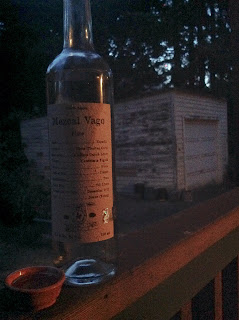Where tequila suffers a self-imposed image problem of salt, lemon, and a necked shot, mezcal has
the worm. The practice of adding a dead animal or insect to a bottled alcoholic liquid exists in many cultures, serving to prove that the liquid is pure - if the worm is decomposing in the bottle, then the drink has been watered down. However, in mezcal the worm (actually an insect larva that eats on the agave plant) is solely a marketing gimmick invented for tourists in the 1950s.
Rather than the debauched, supposedly hallucinogenic appeal of mezcal, it is in fact one of the great spirits, as long as you buy at the top end - there's perhaps no spirit which increases so much in quality with price. On a warm Friday evening in Seattle, a few of us, led by mezcal enthusiast
@drinkaddition, tested five different mezcals side by side; we were expecting quality, but were blown away by the diversity and depth of flavours.
how is it different from tequila?
Tequila must come from around the towns of Tequila and Guadalajara and be made from the blue agave. Mezcal can come from a wider range of places in Mexico (though usually Oaxaca) and be made from the maguey plant, a form of agave and of which there are many varieties. At the cheaper end of the spectrum, this means a much lower level of quality control; for more expensive mezcal, it allows a greater expression of flavours from the plant, the production, and the region. Mezcal undergoes roughly the same production process as tequila, but the plant is roasted in underground ovens, which imparts serious smoky, earthy aromas.
 |
| the line up |
tasting
Made solely from the espadín agave, the most commonly used of the maguey agave. In this case, the plant was sourced from lower altitude, resulting in more sugar and alcohol (52.1%). Despite that high alcohol, this is a very balanced spirit, the alcohol delivering a spicy warmth rather than a harsh heat. As the first mezcal we tasted, it seemed extremely earthy and smoky - almost as much so as a Scotch - though when we came back to it having tasted the others those flavours had calmed down. Beyond those earthy aromas were some saltiness, with a peppery finish, with citrus aromas giving it freshness. A remarkably complex, engaging, and refreshing drink given the high alcohol.
 |
| Mezcal Vago Espadin |
Again from the espadín agave and again high alcohol (51%), though again remarkably well integrated. This was a little overpowered by the previous spirit, being quite delicate; even so, I felt it lacking in power. Floral (jasmine) and peachy, with a spicy finish kicking out of the delicacy. A subtle example of mezcal, showing how two spirits from the same source can be quite different.
 |
| Pierde Almas Espadin |
The Del Maguey "brand" showcases small, artisanal producers from Mexican villages and has rightly gained an international reputation, due to the variety, individuality, and quality of the spirits. Once more from the espadín agave but with a slightly lower alcohol (48%), and with much saltier flavours - brine and salty melon. Smoky too, with a spicy finish on the tongue. Layered and serious.
The first three spirits demonstrated how the same source (the espadín agave) can produce three quite different drinks, though with clear similarities. The fourth showed how a slightly different source (the dobodaán agave) can take the drink in a completely different direction. The dobodaán is a wild agave, grown at low, jungle-like altitudes and tropical aromas were evident: pineapple, coconut, Malibu, and juicy watermelon; a fiery (50.2%) drink, yet oily, soapy, and greasy, with salty spices.
A different agave which grows wild only at high altitude; there are just 600 bottles of this spirit bottled each year. A quite astonishing drink, with strong, immediate aromas of caramel, toffee, treacle, and vanilla on the nose; likewise, rich and creamy on the palate developing into a cinnamon nuttiness, finished off with a long, long smoky, spicy finish. Taken on its own, this is a complex, unforgettable drink, but to think that these involved aromas come from one source - a variety of the agave - without any oak ageing or other interference to produce such a distinct, individual drink is extraordinary.
Five mezcals, from three agave varieties and three producers: this is a diverse, sometimes extraordinary drink. Del Maguey proved why they have the leading international reputation but the whole tasting emphasised that good mezcal is well worth seeking out. It's expensive, but for a good reason.
And if you are wise enough to follow our lead and have your own Mezcal tasting, here's a
spotify playlist to provide a soundtrack.




No comments:
Post a Comment